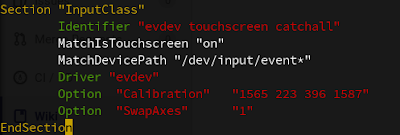Touchscreen mouse calibration is tested for the following OS:
- Description: Debian GNU/Linux 9.1 (stretch)
- Release: 9.1
- ernel: Linux 4.9.0-3-686-pae
- Architecture: x86
For touch screen we can use libinput or evdev driver. Libinput replaces the evdev driver. The configuration below is created for evdev. In the other words We use evdev.
- Get information about xserver-xorg-input.
dpkg -l | grep xserver-xorg-input
Result:
As we see there is no evdev driver.
- Let's install evdev driver.
apt-get install xserver-xorg-input-evdev
- Check if evdev driver is installed
dpkg -l | grep xserver-xorg-input
Result:
- Check if configuration files are in /usr/share/X11/xorg.conf.d directory.
cd /usr/share/X11/xorg.conf.d
ls
result:
10-amdgpu.conf 10-evdev.conf 10-quirks.conf 40-libinput.conf 70-wacom.conf
- now remove libinput driver or we can just remove touch screen section from libinput driver configuration file.
in order to remove libinput driver with dependent packages:
apt-get remove --auto-remove xserver-xorg-input-libinput
in order to disable libinput touch scree:
open 40-libinput.conf and remove a touchscreen InputClass Section that is shown in image below.
- now install xinput-calibrator
sudo apt-get install xinput-calibrator
- Check if you need to swap axes. if you need to swap just run:
xinit set-int-prop "eGalax Inc." "Evdev Axes Swap" 8 1
- Run calibrator to get correct x,y positions.
xinput_calibrator --output-type xinput
The result will be like this:
Now everything should be fine, but if we want to make calibration permanent (after system restart), open 10-evdev.conf config, find touch screen section and add "Calibration" and "SwapAxes" entries.
If we don't want to touch evdev configuration we can run the folloing command after X11 load:
xinput set-prop "eGalax Inc." "Evdev Axis Calibration" 1543, 222, 409, 1582
xinput set-prop "eGalax Inc." "Evdev Axes Swap" 1
if you want to configure libinput instead of evdev, remove evdev driver and install lib input if the last one is removed:
dpkg -P xserver-xorg-input-evdev
apt-get install xserver-xorg-input-libinput










